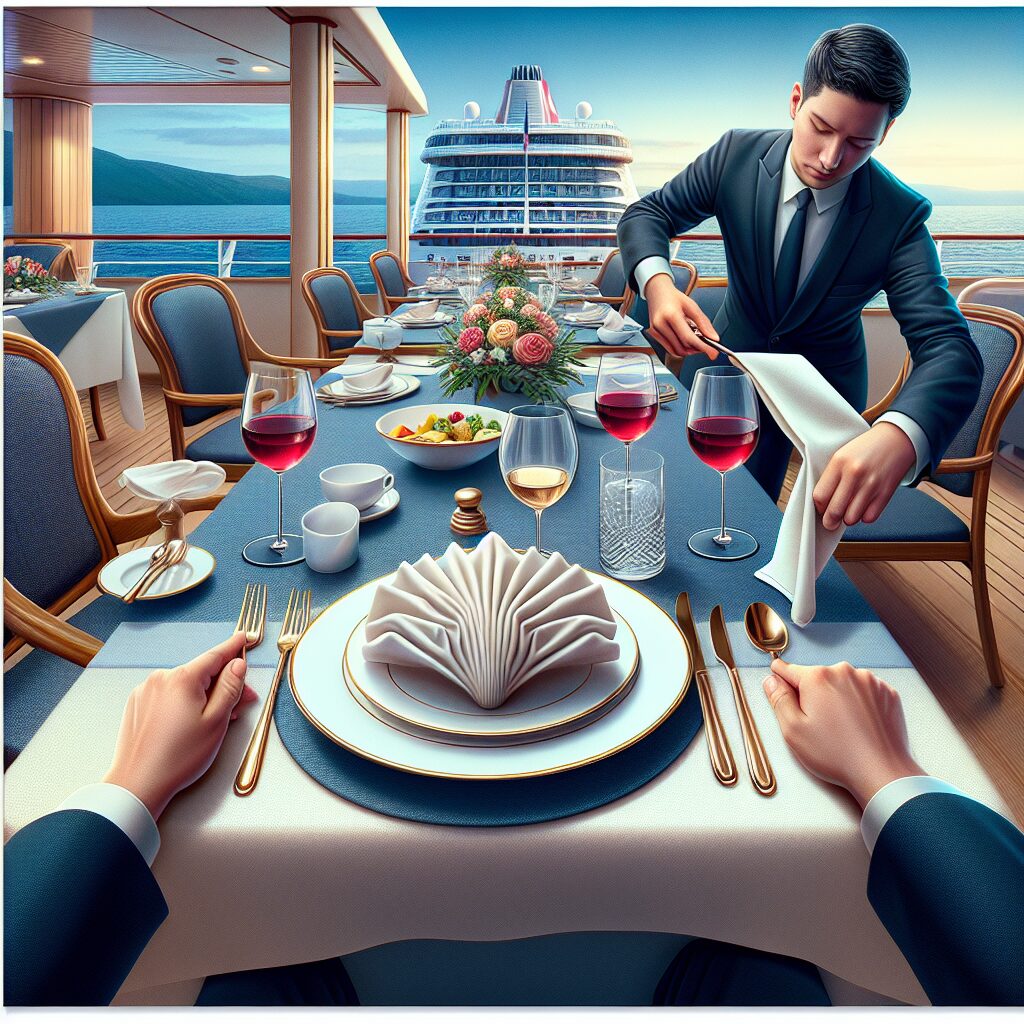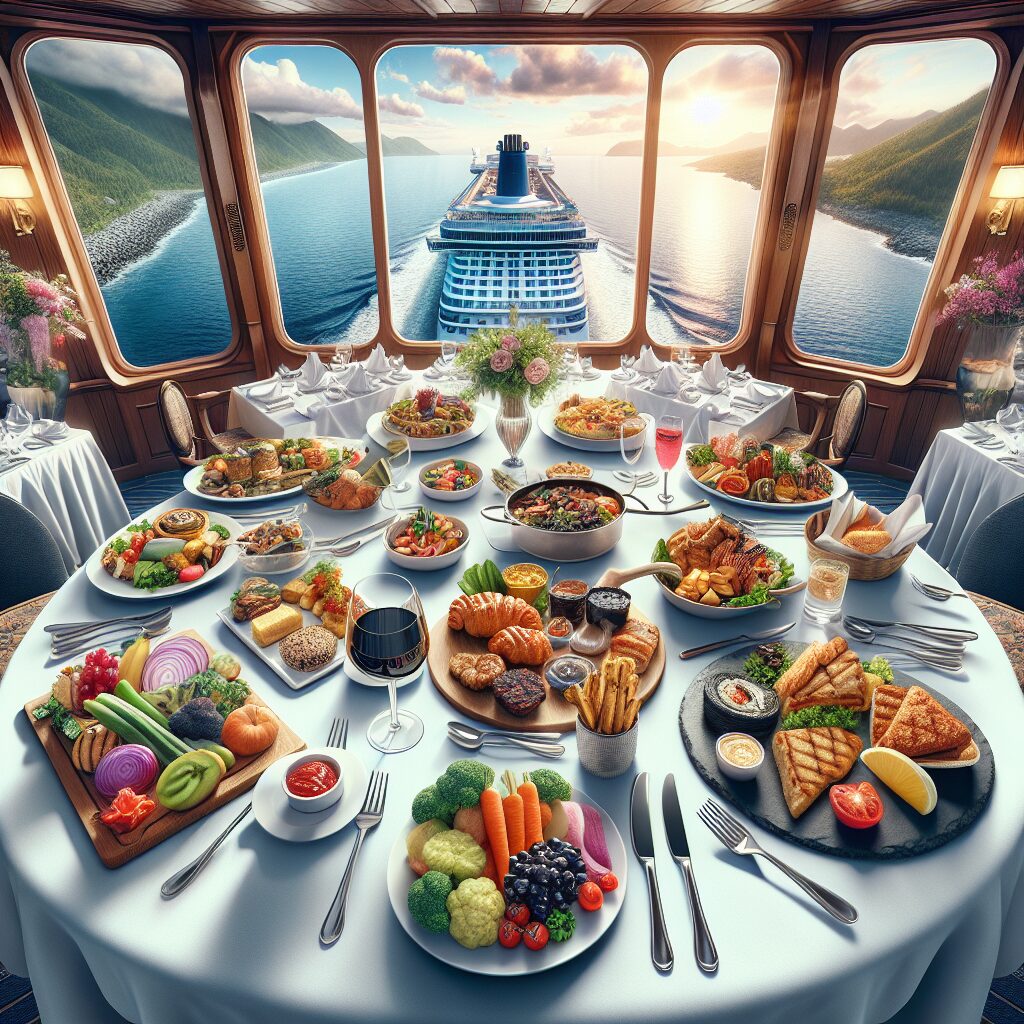Mastering Cruise Dining Etiquette is crucial for those who want to fully enjoy their vacation and make the most of their dining experiences on board. Whether you are a seasoned cruiser or a first-time cruiser, understanding and adhering to the proper dining etiquette can greatly enhance your overall experience. Did you know that cruise ships often offer a variety of dining options, including formal dining rooms, buffet-style restaurants, specialty restaurants, and even room service? Knowing how to navigate these dining venues and understanding the unique rules and expectations can make a significant difference in your cruise dining experience.
One key impact of mastering cruise dining etiquette is the ability to seamlessly blend in with fellow passengers and adapt to different dining environments. Each dining venue on a cruise ship has its own set of rules and conventions, and being aware of these will help you feel more comfortable and confident. Additionally, understanding the proper etiquette can ensure that you have a positive interaction with the ship’s staff and fellow diners, creating a respectful and enjoyable atmosphere for everyone. In this article, we will discuss some key takeaways to help you navigate the world of cruise dining, including dress codes, table manners, and dining tips to make your experience unforgettable. Stay tuned for expert advice on how to impress your fellow diners and make the most of your cruise dining experience.
Key Takeaways
1. Dining etiquette on a cruise ship carries its own unique set of customs and expectations. Passengers should be aware of the dress code, table manners, and seating arrangements in the dining room to ensure a pleasant experience.
2. The dress code for cruise ship dining varies, but it’s essential to adhere to the guidelines provided by the cruise line. Formal nights usually require cocktail dresses or suits, while casual nights allow for smart-casual attire.
3. Seating arrangements in the dining room may be assigned or open. If given the chance, passengers can request a specific table size or location. It is important to communicate any seating preferences or needs to the dining staff as soon as possible.
4. Table manners play a significant role in cruise dining etiquette. Basic courtesies such as arriving on time, using utensils correctly, and not speaking with food in the mouth are crucial. Being mindful of others, engaging in conversation, and thanking the servers are also important aspects of dining etiquette.
5. Specialty dining venues on cruise ships offer a more intimate and luxurious dining experience, usually requiring reservations and additional fees. Although the dress code might be slightly relaxed, maintaining proper table manners and etiquette is still expected in these venues.
Rephrased SEO-Optimized Article Title: How can you master cruise dining etiquette for a seamless experience?
Understanding the Importance of Cruise Dining Etiquette
Cruise dining etiquette plays a significant role in enhancing your overall experience onboard. By familiarizing yourself with the proper dining decorum, you can ensure a pleasant atmosphere and respectful interaction with fellow passengers and staff.
Dress Code and Proper Attire
One crucial aspect of mastering cruise dining etiquette is adhering to the dress code. Different cruise lines may have varying dress expectations, ranging from casual to formal. Familiarize yourself with the specific requirements for each dining venue and ensure you pack appropriate attire to avoid any discomfort or embarrassment.
Seating Arrangements and Table Manners
When dining on a cruise, seating arrangements might differ based on the ship and mealtime. Some cruises offer assigned seating while others offer open seating options. Regardless of the arrangement, it is essential to observe proper table manners. Use cutlery starting from the outermost and work your way inward, maintain a good posture, and engage in polite conversation with your dining companions.
Understanding Dining Room Protocols
Each cruise line may have its own set of dining room protocols, and it is crucial to familiarize yourself with them beforehand. This includes knowing the meal times, adhering to the dress code, and following any specific instructions provided by the dining room staff. Understanding and respecting these protocols will ensure a smooth dining experience for everyone.
Special Dietary Requirements and Allergies
If you have any special dietary requirements or allergies, it is important to inform the cruise line in advance. This enables them to make necessary arrangements to accommodate your needs. When onboard, communicate your requirements to the dining staff and consult with them regarding menu options that are suitable for you.
Handling Dining Etiquette Challenges
Occasionally, you may encounter challenging situations or unfamiliar dining customs during your cruise. It is essential to handle such instances with grace. Stay open-minded, observe and follow the lead of fellow passengers or staff members who might be more experienced. By adapting and showing respect, you can navigate these challenges smoothly and enjoy the dining experience to the fullest.
Tips for Mastering Cruise Dining Etiquette:
- Research and familiarize yourself with the specific dress code and dining protocols of your chosen cruise line.
- Pack appropriate attire to ensure compliance with the dress code for various dining venues.
- Respect table manners and engage in polite conversation with your dining companions.
- Notify the cruise line of any special dietary requirements or allergies in advance.
- Communicate your dietary needs to the dining staff onboard and seek their guidance regarding suitable menu options.
- Stay open-minded and adaptable in handling unfamiliar dining customs or etiquette challenges.
- Observe and follow the lead of experienced passengers or staff members in navigating any challenging situations.
Frequently Asked Questions
1. What is cruise dining etiquette?
Cruise dining etiquette refers to the set of manners and customs that should be followed when dining on a cruise ship. It includes proper table manners, dress codes, and other guidelines to ensure a pleasant dining experience for everyone on board.
2. Are there specific dress codes for cruise ship dining?
Yes, most cruise ships have dress codes for their dining venues. These can range from casual attire to formal wear, depending on the time and location of the meal. It is important to familiarize yourself with the dress code and pack appropriate clothing to adhere to it.
3. Can I bring my own food on a cruise ship?
In general, outside food and beverages are not permitted on cruise ships. However, there may be exceptions for certain dietary needs or baby food. It is best to check with the cruise line beforehand to know their specific policies.
4. How do I navigate different dining options on a cruise ship?
Cruise ships offer a variety of dining options, including main dining rooms, specialty restaurants, buffet areas, and room service. It is recommended to familiarize yourself with the ship’s dining venues and make reservations, if necessary, to ensure availability and avoid long wait times.
5. Is tipping customary in cruise ship dining?
Yes, tipping is customary on cruise ships, especially for the dining staff who provide excellent service. Most cruise lines have automatic gratuity charges added to your onboard account, but additional tips are always appreciated for exceptional service.
6. Can I request special dietary accommodations on a cruise ship?
Absolutely! Cruise lines usually offer a variety of dietary options, including vegetarian, gluten-free, vegan, and kosher meals. It is essential to inform the cruise line of your dietary needs in advance, preferably at the time of booking, so they can make necessary arrangements.
7. Should I adhere to dining etiquettes when dining with friends or family on a cruise ship?
Yes, even when dining with friends or family, it is important to follow dining etiquettes and respect the rules set by the cruise line. By doing so, you contribute to a pleasant and harmonious dining experience for everyone on board.
8. How can I avoid excessive waste when dining on a cruise ship?
To avoid excessive waste, it is advisable to take only the amount of food you can eat and ask for refills if necessary. Additionally, participating in buffet-style dining responsibly, without over-filling your plate, can help minimize food wastage.
9. Can I request a different table or dining time on a cruise ship?
Most cruise lines allow guests to request a specific table or dining time, however, it is subject to availability. It is recommended to make such requests in advance during the booking process to enhance your dining experience on the cruise.
10. Are children required to adhere to cruise dining etiquette?
Yes, children are expected to follow cruise dining etiquette, although some flexibility may be given for younger ones. It is beneficial to educate children about proper table manners before embarking on the cruise to ensure a positive dining experience for everyone.
Final Thoughts
Mastering cruise dining etiquette is essential to fully enjoy and appreciate the dining experiences on a cruise ship. By following the rules and guidelines, you not only show respect to the staff and other passengers but also enhance the overall atmosphere during meals. The impeccable dining etiquette that you display will undoubtedly contribute to making your cruise experience a memorable and pleasant one.
Remember, dining on a cruise ship is an opportunity to savor delicacies from around the world while being pampered by top-notch service. So, take the time to understand the specific dining customs of your cruise line, pack accordingly, and embrace the experience with grace and gratitude. Bon appétit!



